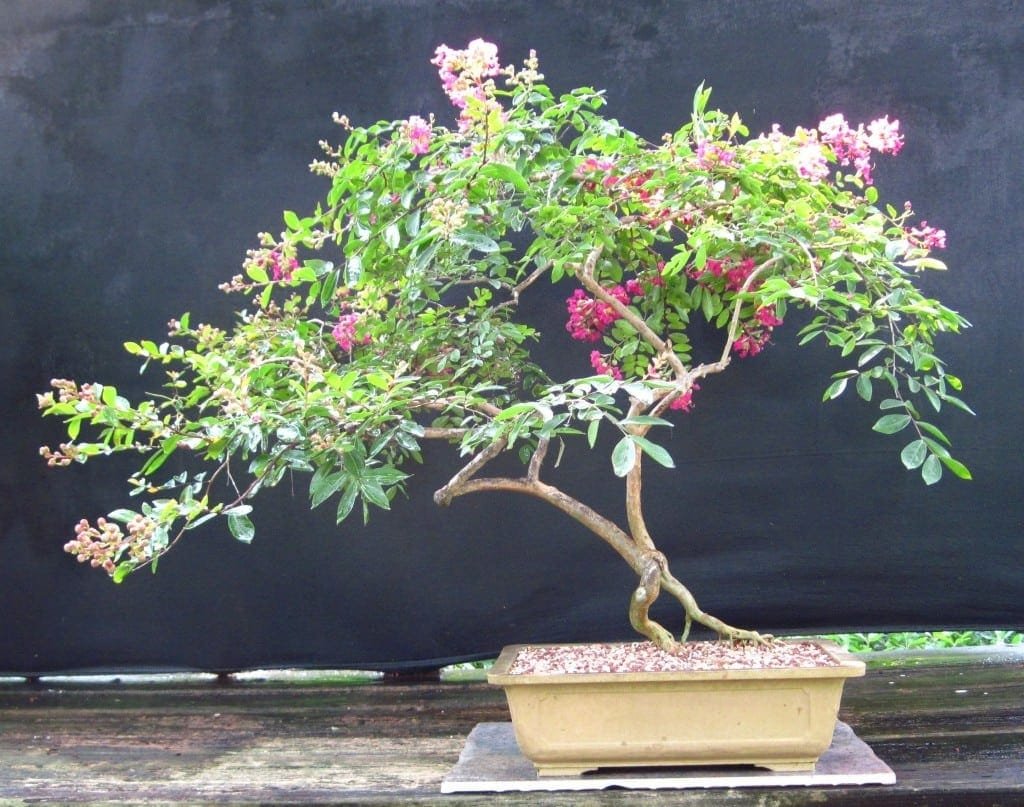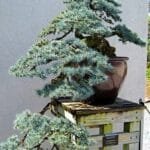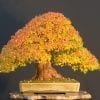The Crepe Myrtle Bonsai is a small tree, native to Asia and Australia, with deciduous leaves. The Crepe Myrtle has a lot to offer for any Bonsai collector. Not only for the crepe-like flowers that it’s named for, but for the varying colors of the bark as it sheds from season to season. This particular Bonsai has a lot of interesting traits that will be discussed in this article.
| Scientific/Botanical Name | Lagerstroemia indica |
| Description | This ornamental tree may be single-trunked or twin-trunked. It has an upright habit and small green leaves. It is available in a number of varieties, and a wide range of bloom colors. |
| Position | Crepe Myrtle trees enjoy full sun, which is beneficial to flowering. Plentiful sunlight also helps to keep fungal growth and pests at bay. Crepe Myrtle likes humid conditions: Use of a gravel tray and regular misting can help to recreate this environment. |
| Watering | Water the tree frequently during periods of grown to ensure moist conditions. Limit watering during dormancy. |
| Feeding | Feed the plant every two weeks during the growing season, using bonsai fertilizer or slow-release pellets. |
| Leaf and Branch Pruning | Prune the tree at the end of the summer season. This will encourage bud production for the following year. Cutting back hard on the tree will encourage the trunk to become thicker. As such, the nature of the pruning undertaken will be dictated by the attributes that are desired of the tree. |
| Re-potting & Growing Medium | Re-pot the tree as needed. Soil that comprises two-fifths of organic matter is beneficial to tree growth and flowering. Introducing some manure into the soil will fix nitrogen, which helps to promote leaf development and growth. |
| Wiring | The tree may be shaped by pruning or by wiring. If wiring is to be undertaken, it is best to do so during the growing season. However, the bark should be handled in a careful manner. |
| Notes | Crepe Myrtle trees may be enhanced by deadwood characteristics. This can be achieved through carving, or by encouraging new growth on die-back wood. |
About The Crepe Myrtle Bonsai
While some of these trees can grow as high as 100 feet, quite a few of them are only 1 foot, and most grow as small trees, or large shrubs. The Crepe Myrtle is named after the flowers that it’s famous for, because of the flower’s crepe-like, crinkled petals.
These flowers range in color from deep lilac, pink, to white. They only bud for short periods of time, usually between June and August, making it all the more magnificent when they do.
In fall, the Crepe Myrtle has a brilliant show of color as the leaves begin to fall. The color ranges from bright yellow to deep red-orange. The bark also varies in color, as it peels. Throughout the seasons, the bark can vary from red to silver in color.
The bark is a spectacular sight in the fall and winter. This tree is sometimes used for its wood, but it’s primarily an ornamental tree, designed to be grown in a container.
Where To Find A Crepe Myrtle Bonsai
The Crepe Myrtle Bonsai can be found in landscape nurseries around the world. Sizes that they offer may range from gallon-sized, to the size of a full tree. These trees take a long time to thicken, so if you’re looking to have a thick trunk, choose a larger tree with a thicker trunk to begin with. Because these trees can take years to thicken, it will give you a head start.
Caring
First of all, if you want the tree to bloom flowers, you have to keep one thing in mind: flowers bloom at the end of new growth. This means that if you cut back branches to help build the tree, you’ll miss out on the flowers. This is especially important to keep in mind if you’re planning to build structure with pruning.
Potting And Soil
Free draining, well-aerated soil works best for the Crepe Myrtle, but it will also need organic matter (about 40% organic matter is best, composted bark is a good choice) to support growth, particularly flower growth in the summer, and leaf growth in the spring. It wouldn’t hurt to add some composted manure in the soil as well, which will offer nitrogen that can aid in leaf production.
The Crepe Myrtle should be re-potted every 1-2 years, before spring occurs. It’s best to re-pot when night temperatures are reaching roughly 50 degrees.
Lighting, Site, And Temperature
The Crepe Myrtle grows best in full sun, no shade necessary. Full light promotes flowering, and helps keep the tree pest and fungi free. While they are able to withstand the shade, too little light may result in larger leaves. It can be grown as an indoor plant, but temperatures should be kept around 45-54 degrees during the winter. Try to keep temperature and lighting fairly consistent, as a constantly changing situation may result in sappy growth.
Feeding And Watering
It should be fed roughly every two weeks in spring and autumn. Try alternating between general plant foods and Bonsai foods.
Pruning, Shaping And Wiring
The Crepe Myrtle Bonsai is fairly easy to shape, just so long as you’re careful of the flower growth. For the most part, they respond well to both wiring and pruning. If you choose to prune for shape, it’s best to do it in the Autumn season, because it can stimulate bud production in the next year. However, if you prune too heavily for shape, you may sacrifice flowering altogether, if only temporarily.
It’s recommended to cut the tree back quite a bit, and then to let it grow freely for the course of 1 year. This will thicken the trunk. If you’re interested in improving branch ramification, try pinching the tree constantly for the next year. If pruning stops before the budding period, there’s a chance that the tree will still flower.
If you’d like, it’s possible to carve deadwood features onto the Crepe Myrtle as well, because the wood is extremely durable. It can even form its own if they go through a dieback and regrowth.
The Crepe Myrtle can be wired from Spring to Autumn, but you’ll have to be careful to protect the bark. The branches are fairly easy to shape both with wiring and pruning, so both methods are effective.
Pests And Diseases
If the tree is kept in humid or low-light conditions, or watered frequently, powdery mildew is a possibility. However, there a number of mildew resistant breeds that are available to eliminate this problem. Aphids are a possibility as well. If Aphids become present, try spraying new foliage tips with water.


